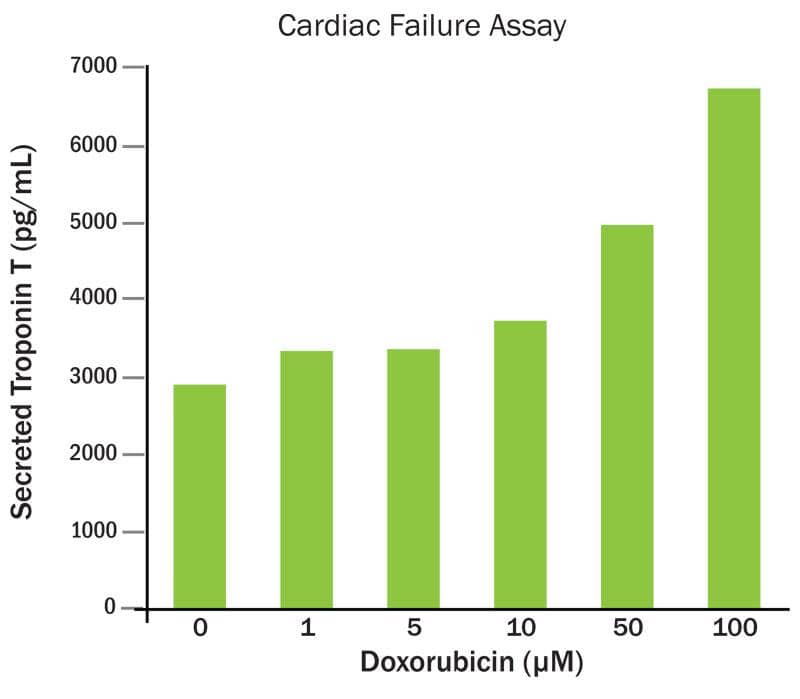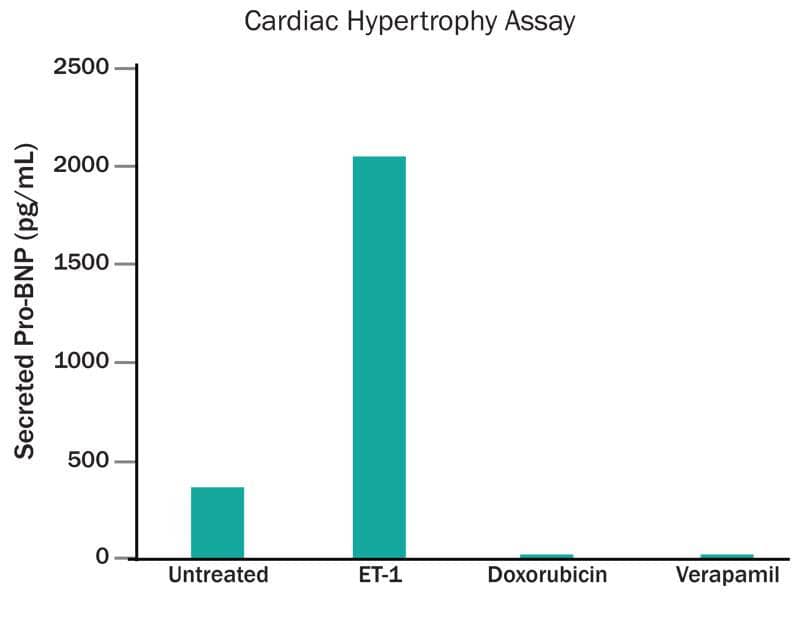Submit a Review & Earn an Amazon Gift Card
You can now submit reviews for your favorite Tocris products. Your review will help other researchers decide on the best products for their research. Why not submit a review today?!
Submit ReviewDoxorubicin hydrochloride is a 14-hydroxylated version of Daunorubicin (Cat. No. 1467) that is naturally fluorescent. Doxorubicin is an antitumor antibiotic agent that inhibits DNA topoisomerase II. It is a DNA intercalator that inhibits nucleic acid synthesis and induces apoptosis. Doxorubicin reduces intracellular tau levels. Doxorubicin also promotes formation of free radicals for the disruption of membrane lipids and DNA strands. Doxorubicin fluorescence is quenched upon intercalation into the DNA; while binding to histones or partitioning into the phospholipid phase of PEG-phospholipid micelles or hydrophobic cores of polymeric micelles, increases Doxorubicin fluorescence. Doxorubicin fluorescence enables the monitoring of the localization of the drug within lipid bilayers and liposomal delivery systems and interaction of the drug with DNA and other macromolecules, as well as drug efflux pump activities.
 View Larger
View Larger
Doxorubicin induces secretion of Troponin T from pluripotent stem cell-derived cardiomyocytes Cardiomyocytes were treated with increasing doses of Doxorubicin (Catalog # 2252) for 24 hours. High concentration or extended exposure to Doxorubicin is known to induce heart failure. Doxorubicin-induced cardiac failure was quantified by measuring secreted Troponin T, a known biomarker of heart failure. Troponin T was detected via Luminex® bead-based multiplex assay (Catalog # LXSAH). Increased levels of secreted Troponin T are observed with increasing concentrations of Doxorubicin.
 View Larger
View Larger
Pluripotent stem cell-derived cardiomyocytes secrete Pro-BNP in response to small molecule-induction of cardiac hypertrophy Cardiomyocytes were treated with the vasoconstrictor, ET-1 (Endothelin-1; Catalog # 1160), or one of two L-type calcium channel inhibitors, Doxorubicin (Catalog # 2252) or Verapamil (Catalog # 0654). Levels of the cardiac hypertrophy marker, Pro-Brain Natriuretic Peptide (Pro-BNP), were detected via Luminex® bead-based multiplex assay (Catalog # LXSAH). A substantial increase in Pro-BNP was detected in the medium of cardiomyocytes treated with ET-1, a known inducer of cardiac hypertrophy. Conversely, Doxorubicin and Verapamil decreased Pro-BNP secretion from cardiomyocytes.
Doxorubicin hydrochloride is also offered as part of the Tocriscreen 2.0 Max, Tocriscreen Antiviral Library, Tocriscreen Epigenetics Library and Tocriscreen FDA-Approved Drugs. Find out more about compound libraries available from Tocris.
| M. Wt | 579.99 |
| Formula | C27H29NO11.HCl |
| Storage | Desiccate at RT |
| Purity | ≥98% (HPLC) |
| CAS Number | 25316-40-9 |
| PubChem ID | 443939 |
| InChI Key | MWWSFMDVAYGXBV-RUELKSSGSA-N |
| Smiles | OC1=C(C[C@]([C@](CO)=O)(O)C[C@@H]4O[C@@]5([H])C[C@H](N)[C@H](O)[C@H](C)O5)C4=C(O)C3=C1C(C2=CC=CC(OC)=C2C3=O)=O.Cl |
The technical data provided above is for guidance only. For batch specific data refer to the Certificate of Analysis.
Tocris products are intended for laboratory research use only, unless stated otherwise.
| Solvent | Max Conc. mg/mL | Max Conc. mM | |
|---|---|---|---|
| Solubility | |||
| water | 29 | 50 | |
| DMSO | 29 | 50 |
The following data is based on the product molecular weight 579.99. Batch specific molecular weights may vary from batch to batch due to the degree of hydration, which will affect the solvent volumes required to prepare stock solutions.
| Concentration / Solvent Volume / Mass | 1 mg | 5 mg | 10 mg |
|---|---|---|---|
| 0.5 mM | 3.45 mL | 17.24 mL | 34.48 mL |
| 2.5 mM | 0.69 mL | 3.45 mL | 6.9 mL |
| 5 mM | 0.34 mL | 1.72 mL | 3.45 mL |
| 25 mM | 0.07 mL | 0.34 mL | 0.69 mL |
References are publications that support the biological activity of the product.
Skladanowski and Konopa (1993) Adriamycin and daunomycin induce programmed cell death (apoptosis) in tumour cells. Biochem.Pharmacol. 46 357 PMID: 8347161
Patel et al (1997) Identification of yeast DNA topoisomerase II mutants resistant to the antitumor drug doxorubicin: implications for the mechanisms of dox. action and cyotoxicity. Mol.Pharmacol. 52 658 PMID: 9380029
Gewirtz (1999) A critical evaluation of the mechanisms of action proposed for the antitumor effects of the anthracycline antibiotics adriamycin and daunoru. Biochem.Pharmacol. 57 727 PMID: 10075079
Dickey et al (2006) Pharmacologic reductions of total tau levels; implications for the role of microtubule dynamics in regulating tau expression. Mol.Neurodegen. 1 6 PMID: 16930453
Karukstis et al (1998) Deciphering the fluorescence signature of daunomycin and doxorubicin. Biophys.Chem 73 249 PMID: 9700924
Mohan et al (2010) Doxorubicin as a molecular nanotheranostic agent: effect of doxorubicin encapsulation in micelles or nanoemulsions on the ultrasound-mediated intracellular delivery and nuclear trafficking. Mol.Pharm. 7 1959 PMID: 20957997
If you know of a relevant reference for Doxorubicin hydrochloride, please let us know.
Keywords: Doxorubicin hydrochloride, Doxorubicin hydrochloride supplier, Antitumor, antibiotics, agent, inhibitors, inhibits, DNA, topoisomerase, II, Isomerases, NSC123127, chemotherapeutics, fluorescence, drug, efflux, pump, Adriamycin, NSC, 123127, Topoisomerase, Apoptosis, Inducers, Antibiotics, 2252, Tocris Bioscience
Citations are publications that use Tocris products. Selected citations for Doxorubicin hydrochloride include:
Bussey et al (2016) Targeting polo-like kinase 1, a regulator of p53, in the treatment of adrenocortical carcinoma. PLoS One 5 1 PMID: 26754547
Thomas et al (2016) The α-1A Adrenergic Receptor in the Rabbit Heart. Mol Syst Biol 11 e0155238 PMID: 27258143
Duff et al (2018) Regulation of senescence escape by the cdk4-EZH2-AP2M1 pathway in response to chemotherapy. Cell Death Dis 9 199 PMID: 29415991
Ali et al (2017) Isolation and characterization of a new naturally immortalized human breast carcinoma cell line, KAIMRC1. BMC Cancer 17 803 PMID: 29187162
Beak et al (2017) An Oral Selective Alpha-1A Adrenergic Receptor Agonist Prevents Drug-induced Cardiotoxicity. JACC Basic Transl Sci 2 39 PMID: 28286875
Gallagher et al (2017) Lysosomotropism depends on glucose: a chloroquine resistance mechanism. Cell Death Dis 8 e3014 PMID: 28837152
Tavangar et al (2017) AMB potentiates the anticancer activity of Drug-induced on the MCF-7 breast cancer cells. J Chem Biol 10 143 PMID: 28685000
Sundaresan et al (2014) Dual-responsive polymer-coated iron oxide nanoparticles for drug delivery and imaging applications. Int J Pharm 466 1 PMID: 24607216
Smyth et al (2015) Biodistribution and delivery efficiency of unmodified tumor-derived exosomes. J Control Release 199 145 PMID: 25523519
Guillon et al (2019) Regulation of senescence escape by TSP1 and CD47 following chemotherapy treatment. Cell Death Dis 10 199 PMID: 30814491
Yoon et al (2019) p53 induces senescence through Lamin A/C stabilization-mediated nuclear deformation. Cell Death Dis 10 107 PMID: 30728349
Kanchanapally et al (2019) Drug-loaded exosomal preparations from different cell types exhibit distinctive loading capability, yield, and antitumor efficacies: a comparative analysis. Int J Nanomedicine 14 531 PMID: 30666112
El Zawily (2017) The EphB6 receptor is overexpressed in pediatric T cell acute lymphoblastic leukemia and increases its sensitivity to dox. treatment. Sci Rep 7 14767 PMID: 29116180
Zhitomirsky and Assaraf (2015) Lysosomal sequestration of hydrophobic weak base chemotherapeutics triggers lysosomal biogenesis and lysosome-dependent cancer multidrug resistance. Clin Transl Med 6 1143 PMID: 25544758
Lee et al (2019) Extracorporeal shock waves protect cardiomyocytes from DOX-induced cardiomyopathy by upregulating survivin via the integrin-ILK-Akt-Sp1/p53 axis. Sci Rep 9 12149 PMID: 31434946
Ayoub (2017) Crizotinib, a MET inhibitor, inhibits growth, migration, and invasion of breast cancer cells in vitro and synergizes with chemotherapeutic agents. Onco Targets Ther 10 4869 PMID: 29042798
Montgomery (2017) An Alpha-1A Adrenergic Receptor Agonist Prevents Acute dox. Cardiomyopathy in Male Mice. Plos One 12 e0168409 PMID: 28081170
Gharanei et al (2013) Attenuation of doxorubicin-induced cardiotoxicity by mdivi-1: a mitochondrial division/mitophagy inhibitor. PLoS One 8 e77713 PMID: 24147064
Toldo et al (2013) Comparative cardiac toxicity of anthracyclines in vitro and in vivo in the mouse. PLoS One 8 e58421 PMID: 23516478
Robinson et al (2013) RB1 status in triple negative breast cancer cells dictates response to radiation treatment and selective therapeutic drugs. PLoS One 8 e78641 PMID: 24265703
Yuan et al (2017) Tenovin-6 impairs autophagy by inhibiting autophagic flux. Cell Death Dis 8 e2608 PMID: 28182004
Aho et al (2016) Extracellular ATP protects endothelial cells against DNA damage. Purinergic Signal 12 575 PMID: 27030122
Thomas et al (2016) A Myocardial Slice Culture Model Reveals Alpha-1A-Adrenergic Receptor Signaling in the Human Heart. JACC Basic Transl Sci 1 155 PMID: 27453955
Gligorich et al (2013) Development of a screen to identify selective small molecules active against patient-derived metastatic and chemoresistant breast cancer cells. Breast Cancer Res 15 R58 PMID: 23879992
Iriondo (2018) TAK1 mediates microenvironment-triggered autocrine signals and promotes triple-negativebreast cancer lung metastasis. Nat Commun 9 1994 PMID: 29777109
Natrajan et al (2012) Functional characterization of the 19q12 amplicon in grade III breast cancers. Breast Cancer Res 14 R53 PMID: 22433433
Hayano et al (2016) Loss of cysteinyl-tRNA synthetase (CARS) induces the transsulfuration pathway and inhibits ferroptosis induced by cystine deprivation. Cell Death Differ 23 270 PMID: 26184909
Lim et al (2008) B cell translocation gene 2 enhances susceptibility of HeLa cells to doxorubicin-induced oxidative damage. J Biol Chem 283 33110 PMID: 18840609
Do you know of a great paper that uses Doxorubicin hydrochloride from Tocris? Please let us know.
There are currently no reviews for this product. Be the first to review Doxorubicin hydrochloride and earn rewards!
$25/€18/£15/$25CAN/¥75 Yuan/¥2500 Yen for a review with an image
$10/€7/£6/$10 CAD/¥70 Yuan/¥1110 Yen for a review without an image
Tocris offers the following scientific literature in this area to showcase our products. We invite you to request* your copy today!
*Please note that Tocris will only send literature to established scientific business / institute addresses.
This product guide provides a background to Huntington's disease research and lists around 100 products for the study of:
In normal cells, each stage of the cell cycle is tightly regulated, however in cancer cells many genes and proteins that are involved in the regulation of the cell cycle are mutated or over expressed. This poster summarizes the stages of the cell cycle and DNA repair. It also highlights strategies for enhancing replicative stress in cancer cells to force mitotic catastrophe and cell death.